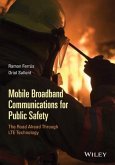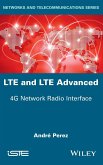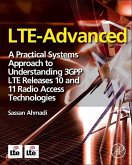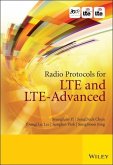- Gebundenes Buch
- Merkliste
- Auf die Merkliste
- Bewerten Bewerten
- Teilen
- Produkt teilen
- Produkterinnerung
- Produkterinnerung
Public safety networks provide highly robust communication systems which can address the specific needs of emergency services. This has fostered the need for public safety standards -- such as TETRA and P25 -- that provide a set of features not supported in commercial cellular systems. This book provides an in-depth analysis for adopting LTE (Long Term Evolution, the 4G 3GPP radio technology) as the technology of choice, to provide mission-critical communication services. Written by four industry professionals, LTE for Public Safety explains how LTE can be used as technology enabler for Public…mehr
Andere Kunden interessierten sich auch für
![From GSM to LTE-Advanced 4Ed C From GSM to LTE-Advanced 4Ed C]() Martin SauterFrom GSM to LTE-Advanced 4Ed C130,99 €
Martin SauterFrom GSM to LTE-Advanced 4Ed C130,99 €![Introduction to Mobile Network Engineering: Gsm, 3g-Wcdma, Lte and the Road to 5g Introduction to Mobile Network Engineering: Gsm, 3g-Wcdma, Lte and the Road to 5g]() Alexander KukushkinIntroduction to Mobile Network Engineering: Gsm, 3g-Wcdma, Lte and the Road to 5g129,99 €
Alexander KukushkinIntroduction to Mobile Network Engineering: Gsm, 3g-Wcdma, Lte and the Road to 5g129,99 €![Lte Small Cell Optimization Lte Small Cell Optimization]() Lte Small Cell Optimization116,99 €
Lte Small Cell Optimization116,99 €![Mobile Broadband Communications for Public Safety Mobile Broadband Communications for Public Safety]() Ramon FerrúsMobile Broadband Communications for Public Safety107,99 €
Ramon FerrúsMobile Broadband Communications for Public Safety107,99 €![Lte and Lte Advanced Lte and Lte Advanced]() André PérezLte and Lte Advanced176,99 €
André PérezLte and Lte Advanced176,99 €![Lte-Advanced Lte-Advanced]() Sassan AhmadiLte-Advanced116,99 €
Sassan AhmadiLte-Advanced116,99 €![Radio Protocols for Lte and Lte-Advanced Radio Protocols for Lte and Lte-Advanced]() Seungjune YiRadio Protocols for Lte and Lte-Advanced156,99 €
Seungjune YiRadio Protocols for Lte and Lte-Advanced156,99 €-
-
-
Public safety networks provide highly robust communication systems which can address the specific needs of emergency services. This has fostered the need for public safety standards -- such as TETRA and P25 -- that provide a set of features not supported in commercial cellular systems. This book provides an in-depth analysis for adopting LTE (Long Term Evolution, the 4G 3GPP radio technology) as the technology of choice, to provide mission-critical communication services. Written by four industry professionals, LTE for Public Safety explains how LTE can be used as technology enabler for Public Safety networks. It provides an in-depth analysis on how LTE can be used by the emergency responders for their own dedicated mission-critical network and the specialized features that are needed in LTE for providing robust and mission-critical communications amongst first responders. These include features such as group call communication and proximity services, also referred to as "LTE Direct" or Device to Device communication and discovery. It also provides a basic overview of the technology and some of the most important services available in LTE, providing also a justification why LTE was adopted for future Public Safety networks. The aim of the book is to educate government agencies, operators, vendors, and other regulatory institutions how LTE can be deployed to serve public safety markets. It also aims to educate people who are interested to understand how proximity services are supported in LTE. It is written in such a way that it can be understood by both technical and nontechnical personnel with just introductory knowledge in wireless communication.
Hinweis: Dieser Artikel kann nur an eine deutsche Lieferadresse ausgeliefert werden.
Hinweis: Dieser Artikel kann nur an eine deutsche Lieferadresse ausgeliefert werden.
Produktdetails
- Produktdetails
- Verlag: Wiley
- Seitenzahl: 260
- Erscheinungstermin: 6. Mai 2015
- Englisch
- Abmessung: 250mm x 175mm x 19mm
- Gewicht: 636g
- ISBN-13: 9781118829868
- ISBN-10: 1118829867
- Artikelnr.: 42057010
- Herstellerkennzeichnung
- Libri GmbH
- Europaallee 1
- 36244 Bad Hersfeld
- gpsr@libri.de
- Verlag: Wiley
- Seitenzahl: 260
- Erscheinungstermin: 6. Mai 2015
- Englisch
- Abmessung: 250mm x 175mm x 19mm
- Gewicht: 636g
- ISBN-13: 9781118829868
- ISBN-10: 1118829867
- Artikelnr.: 42057010
- Herstellerkennzeichnung
- Libri GmbH
- Europaallee 1
- 36244 Bad Hersfeld
- gpsr@libri.de
RAINER LIEBHART, Nokia, Germany DEVAKI CHANDRAMOULI, Nokia, USA CURT WONG, Nokia, USA JÜRGEN MERKEL, Nokia, Germany
Foreword xi
About the Authors xiii
Preface xv
Acknowledgments xvii
Introduction xix
Terminology xxi
1 Introduction to LTE/SAE 1
1.1 Role of 3GPP 1
1.2 History of LTE 3
1.3 Drivers for LTE 5
1.4 EPS compared to GPRS and UMTS 6
1.5 Spectrum Considerations 7
1.6 Network Architecture 9
1.6.1 Radio Access Network and Core Network 9
1.6.2 Architecture Principles 9
1.6.3 Non-roaming Architecture 10
1.6.4 Roaming Architectures 11
1.6.5 Description of Functional Entities 12
1.6.6 Session Management 17
1.6.7 Policy and Charging Control 19
1.6.8 Interfaces and Protocols in EPS 21
1.6.9 Mobility Management 26
1.6.10 Intra E-UTRAN Handover 30
1.6.11 Security 31
1.6.12 Charging 34
1.7 IP Multimedia Subsystem 38
1.7.1 Summary of Reference Points and Protocols 40
1.8 Voice and SMS in LTE 41
1.8.1 Voice 41
1.8.2 Short Message Service 42
1.9 Interworking with 2G/3G Networks 43
1.9.1 Overview 43
1.9.2 Interworking with Legacy Networks 43
1.9.3 Functional Description 43
1.10 Interworking with Non-3GPP Access Networks 44
1.10.1 Summary of Reference Points and Protocols 47
1.11 Network Sharing 48
1.11.1 UE-Based Network Selection 49
1.11.2 RAN-Based Network Selection 49
1.12 Multimedia Broadcast Multicast Service 50
1.12.1 Principles 50
1.12.2 Description of Functional Entities 51
1.12.3 MBMS Enhancements 52
1.12.4 MBSFN and MBMS Radio Channels 53
1.13 Terms and Definitions 54
1.13.1 Roaming 54
1.13.2 Circuit-Switched and Packet-Switched Networks 55
1.13.3 Access Stratum and Non-Access Stratum 55
References 56
2 Regulatory Features 59
2.1 Emergency Calls 59
2.1.1 Overview 59
2.1.2 Requirements 59
2.1.3 Emergency Call Architecture 60
2.1.4 PSAP Callback 68
2.1.5 Emergency Numbers 68
2.1.6 Non Voice Emergency Services 69
2.1.7 Automated Emergency Calls 69
2.2 Public Warning System 71
2.3 Lawful Interception 72
2.3.1 Principles 72
2.3.2 Lawful Interception for EPS 74
2.4 Enhanced Multimedia Priority Services 74
References 76
3 LTE for Public Safety Networks 77
3.1 Why LTE for Public Safety Networks? 77
3.2 What are Public Safety Networks? 78
3.3 LTE meets Demands of Public Safety Networks 79
3.4 Wide Range of LTE Devices for Public Safety 80
3.5 Standalone versus Shared Deployments 81
3.6 Interworking 83
3.6.1 Device Aspects 83
3.6.2 Network Aspects 83
References 83
4 Proximity Services 85
4.1 Introduction to Proximity Services 85
4.1.1 Proximity Services Overview 85
4.1.2 ProSe Communication 86
4.1.3 ProSe Discovery 88
4.1.4 ProSe for Public Safety 88
4.2 Proximity Services Architectures 90
4.2.1 Non-roaming Architecture 90
4.2.2 Inter-PLMN Architecture 91
4.2.3 Roaming Architecture 91
4.2.4 Description of Functional Entities 93
4.2.5 Interfaces and Protocols 97
4.3 Synchronization 104
4.3.1 LTE Primary and Secondary Synchronization Signals 106
4.3.2 LTE D2D Synchronization 107
4.4 Service Authorization 108
4.5 ProSe Direct Discovery 109
4.5.1 ProSe Direct Discovery Models 110
4.5.2 ProSe Direct Discovery Modes 110
4.5.3 Direct Discovery Procedure for Model A 111
4.5.4 Radio Aspects and Physical Layer Design 112
4.5.5 Radio Resource Allocation for Direct Discovery 112
4.5.6 Inter-frequency ProSe Discovery 113
4.5.7 Announce Procedure (non-roaming) 114
4.5.8 Announce Procedure (roaming) 115
4.5.9 Monitor Procedure (non-roaming) 117
4.5.10 Monitor Procedure (roaming) 118
4.5.11 Match Procedure (non-roaming) 120
4.5.12 Match Procedure (roaming) 121
4.5.13 Direct Discovery Procedure for Model B 123
4.6 ProSe Direct Communication 123
4.6.1 Radio Aspects and Physical Layer Design 124
4.6.2 Radio Resource Allocation for Direct Communication 125
4.6.3 Inter-frequency ProSe Communication 127
4.6.4 IP Address Allocation 128
4.6.5 One-to-Many Communication (Transmission) 128
4.6.6 One-to-Many Communication (Reception) 130
4.6.7 Direct Communication via ProSe Relay 130
4.7 EPC-Level ProSe Discovery 131
4.7.1 EPC-Level ProSe Discovery Procedure 132
4.7.2 User Equipment Registration 133
4.7.3 Application Registration 134
4.8 Other Essential Functions for Proximity Services 135
4.8.1 Provisioning 135
4.8.2 Subscription Data 136
4.8.3 Security 136
4.8.4 Charging 138
4.8.5 ProSe-Related Identifiers 140
4.8.6 Illustration for Match Event 144
4.9 Deployment Scenarios 146
4.9.1 ProSe Direct Discovery 146
4.9.2 ProSe Direct Communication 147
4.10 Public Safety Use Cases 147
4.10.1 Use Cases for ProSe Communication 148
4.10.2 Use Cases for Network to UE Relay 149
4.10.3 Performance Characteristics 149
4.11 Outlook to Enhanced Proximity Services 150
4.12 Terms and Definitions 151
4.12.1 Home PLMN 151
4.12.2 Equivalent Home PLMN 151
4.12.3 Visited PLMN 151
4.12.4 Registered (Serving) PLMN 152
4.12.5 Local PLMN 152
4.12.6 Hybrid Adaptive Repeat and Request 152
4.12.7 Radio Link Control 152
4.12.8 Logical Channel Prioritization 153
4.12.9 System Information 153
4.12.10 OFDM Symbol 154
4.12.11 Dual-Rx UE 154
References 154
5 Group Communication Over LTE 157
5.1 Introduction to Group Communication Services 157
5.2 Group Communication System Enablers for LTE 158
5.3 Principles of Group Communication over LTE 159
5.4 Functional Entities 162
5.4.1 User Equipment 162
5.4.2 GCS AS 162
5.4.3 BM-SC 163
5.4.4 eNB, MME, S-GW, P-GW, PCRF 163
5.5 Interfaces and Protocols 163
5.5.1 MB2 Interface 163
5.5.2 Rx and SGi Interfaces 167
5.6 GCSE Functions 169
5.6.1 Unicast Delivery 169
5.6.2 MBMS Delivery 171
5.6.3 Service Continuity 172
5.6.4 Priority and Preemption 173
5.6.5 MBMS Delivery Status Notification 175
5.7 Establishment of MBMS Delivery 175
5.7.1 Pre-establishment 175
5.7.2 Dynamic Establishment 176
5.8 MBMS Delivery Procedures 179
5.8.1 MBMS Delivery Modification 179
5.8.2 MBMS Delivery Deactivation 181
5.8.3 TMGI Management 182
5.9 Access Control 183
5.10 Mission Critical Push To Talk 185
5.10.1 MCPTT Service Description 186
5.10.2 MCPTT Call Types 187
5.10.3 MCPTT Priorities 187
5.10.4 Shareable MCPTT Devices 188
5.10.5 On and Off Network Mode of Operation 188
5.10.6 Interworking with legacy PTT Systems 189
References 189
6 Summary and Outlook 191
6.1 Role of LTE 191
6.2 Public Safety Features 192
6.3 LTE for Public Safety 193
6.4 Outlook 196
References 196
Appendix A 197
A.1 Call Flows 197
A.1.1 Attach 197
A.1.2 Detach 200
A.1.3 Tracking Area Update 201
A.1.4 Paging 202
A.1.5 Service Request 203
A.1.6 X2-Based Handover 205
A.1.7 S1-Based Handover 206
A.1.8 MBMS Session Start 210
A.1.9 MBMS Session Stop 212
A.1.10 MBMS Session Update 213
A.1.11 UE-requested PDN Connectivity 214
A.1.12 Dedicated Bearer Context Activation 216
A.2 3GPP Reference Points 217
References 221
Index 223
About the Authors xiii
Preface xv
Acknowledgments xvii
Introduction xix
Terminology xxi
1 Introduction to LTE/SAE 1
1.1 Role of 3GPP 1
1.2 History of LTE 3
1.3 Drivers for LTE 5
1.4 EPS compared to GPRS and UMTS 6
1.5 Spectrum Considerations 7
1.6 Network Architecture 9
1.6.1 Radio Access Network and Core Network 9
1.6.2 Architecture Principles 9
1.6.3 Non-roaming Architecture 10
1.6.4 Roaming Architectures 11
1.6.5 Description of Functional Entities 12
1.6.6 Session Management 17
1.6.7 Policy and Charging Control 19
1.6.8 Interfaces and Protocols in EPS 21
1.6.9 Mobility Management 26
1.6.10 Intra E-UTRAN Handover 30
1.6.11 Security 31
1.6.12 Charging 34
1.7 IP Multimedia Subsystem 38
1.7.1 Summary of Reference Points and Protocols 40
1.8 Voice and SMS in LTE 41
1.8.1 Voice 41
1.8.2 Short Message Service 42
1.9 Interworking with 2G/3G Networks 43
1.9.1 Overview 43
1.9.2 Interworking with Legacy Networks 43
1.9.3 Functional Description 43
1.10 Interworking with Non-3GPP Access Networks 44
1.10.1 Summary of Reference Points and Protocols 47
1.11 Network Sharing 48
1.11.1 UE-Based Network Selection 49
1.11.2 RAN-Based Network Selection 49
1.12 Multimedia Broadcast Multicast Service 50
1.12.1 Principles 50
1.12.2 Description of Functional Entities 51
1.12.3 MBMS Enhancements 52
1.12.4 MBSFN and MBMS Radio Channels 53
1.13 Terms and Definitions 54
1.13.1 Roaming 54
1.13.2 Circuit-Switched and Packet-Switched Networks 55
1.13.3 Access Stratum and Non-Access Stratum 55
References 56
2 Regulatory Features 59
2.1 Emergency Calls 59
2.1.1 Overview 59
2.1.2 Requirements 59
2.1.3 Emergency Call Architecture 60
2.1.4 PSAP Callback 68
2.1.5 Emergency Numbers 68
2.1.6 Non Voice Emergency Services 69
2.1.7 Automated Emergency Calls 69
2.2 Public Warning System 71
2.3 Lawful Interception 72
2.3.1 Principles 72
2.3.2 Lawful Interception for EPS 74
2.4 Enhanced Multimedia Priority Services 74
References 76
3 LTE for Public Safety Networks 77
3.1 Why LTE for Public Safety Networks? 77
3.2 What are Public Safety Networks? 78
3.3 LTE meets Demands of Public Safety Networks 79
3.4 Wide Range of LTE Devices for Public Safety 80
3.5 Standalone versus Shared Deployments 81
3.6 Interworking 83
3.6.1 Device Aspects 83
3.6.2 Network Aspects 83
References 83
4 Proximity Services 85
4.1 Introduction to Proximity Services 85
4.1.1 Proximity Services Overview 85
4.1.2 ProSe Communication 86
4.1.3 ProSe Discovery 88
4.1.4 ProSe for Public Safety 88
4.2 Proximity Services Architectures 90
4.2.1 Non-roaming Architecture 90
4.2.2 Inter-PLMN Architecture 91
4.2.3 Roaming Architecture 91
4.2.4 Description of Functional Entities 93
4.2.5 Interfaces and Protocols 97
4.3 Synchronization 104
4.3.1 LTE Primary and Secondary Synchronization Signals 106
4.3.2 LTE D2D Synchronization 107
4.4 Service Authorization 108
4.5 ProSe Direct Discovery 109
4.5.1 ProSe Direct Discovery Models 110
4.5.2 ProSe Direct Discovery Modes 110
4.5.3 Direct Discovery Procedure for Model A 111
4.5.4 Radio Aspects and Physical Layer Design 112
4.5.5 Radio Resource Allocation for Direct Discovery 112
4.5.6 Inter-frequency ProSe Discovery 113
4.5.7 Announce Procedure (non-roaming) 114
4.5.8 Announce Procedure (roaming) 115
4.5.9 Monitor Procedure (non-roaming) 117
4.5.10 Monitor Procedure (roaming) 118
4.5.11 Match Procedure (non-roaming) 120
4.5.12 Match Procedure (roaming) 121
4.5.13 Direct Discovery Procedure for Model B 123
4.6 ProSe Direct Communication 123
4.6.1 Radio Aspects and Physical Layer Design 124
4.6.2 Radio Resource Allocation for Direct Communication 125
4.6.3 Inter-frequency ProSe Communication 127
4.6.4 IP Address Allocation 128
4.6.5 One-to-Many Communication (Transmission) 128
4.6.6 One-to-Many Communication (Reception) 130
4.6.7 Direct Communication via ProSe Relay 130
4.7 EPC-Level ProSe Discovery 131
4.7.1 EPC-Level ProSe Discovery Procedure 132
4.7.2 User Equipment Registration 133
4.7.3 Application Registration 134
4.8 Other Essential Functions for Proximity Services 135
4.8.1 Provisioning 135
4.8.2 Subscription Data 136
4.8.3 Security 136
4.8.4 Charging 138
4.8.5 ProSe-Related Identifiers 140
4.8.6 Illustration for Match Event 144
4.9 Deployment Scenarios 146
4.9.1 ProSe Direct Discovery 146
4.9.2 ProSe Direct Communication 147
4.10 Public Safety Use Cases 147
4.10.1 Use Cases for ProSe Communication 148
4.10.2 Use Cases for Network to UE Relay 149
4.10.3 Performance Characteristics 149
4.11 Outlook to Enhanced Proximity Services 150
4.12 Terms and Definitions 151
4.12.1 Home PLMN 151
4.12.2 Equivalent Home PLMN 151
4.12.3 Visited PLMN 151
4.12.4 Registered (Serving) PLMN 152
4.12.5 Local PLMN 152
4.12.6 Hybrid Adaptive Repeat and Request 152
4.12.7 Radio Link Control 152
4.12.8 Logical Channel Prioritization 153
4.12.9 System Information 153
4.12.10 OFDM Symbol 154
4.12.11 Dual-Rx UE 154
References 154
5 Group Communication Over LTE 157
5.1 Introduction to Group Communication Services 157
5.2 Group Communication System Enablers for LTE 158
5.3 Principles of Group Communication over LTE 159
5.4 Functional Entities 162
5.4.1 User Equipment 162
5.4.2 GCS AS 162
5.4.3 BM-SC 163
5.4.4 eNB, MME, S-GW, P-GW, PCRF 163
5.5 Interfaces and Protocols 163
5.5.1 MB2 Interface 163
5.5.2 Rx and SGi Interfaces 167
5.6 GCSE Functions 169
5.6.1 Unicast Delivery 169
5.6.2 MBMS Delivery 171
5.6.3 Service Continuity 172
5.6.4 Priority and Preemption 173
5.6.5 MBMS Delivery Status Notification 175
5.7 Establishment of MBMS Delivery 175
5.7.1 Pre-establishment 175
5.7.2 Dynamic Establishment 176
5.8 MBMS Delivery Procedures 179
5.8.1 MBMS Delivery Modification 179
5.8.2 MBMS Delivery Deactivation 181
5.8.3 TMGI Management 182
5.9 Access Control 183
5.10 Mission Critical Push To Talk 185
5.10.1 MCPTT Service Description 186
5.10.2 MCPTT Call Types 187
5.10.3 MCPTT Priorities 187
5.10.4 Shareable MCPTT Devices 188
5.10.5 On and Off Network Mode of Operation 188
5.10.6 Interworking with legacy PTT Systems 189
References 189
6 Summary and Outlook 191
6.1 Role of LTE 191
6.2 Public Safety Features 192
6.3 LTE for Public Safety 193
6.4 Outlook 196
References 196
Appendix A 197
A.1 Call Flows 197
A.1.1 Attach 197
A.1.2 Detach 200
A.1.3 Tracking Area Update 201
A.1.4 Paging 202
A.1.5 Service Request 203
A.1.6 X2-Based Handover 205
A.1.7 S1-Based Handover 206
A.1.8 MBMS Session Start 210
A.1.9 MBMS Session Stop 212
A.1.10 MBMS Session Update 213
A.1.11 UE-requested PDN Connectivity 214
A.1.12 Dedicated Bearer Context Activation 216
A.2 3GPP Reference Points 217
References 221
Index 223
Foreword xi
About the Authors xiii
Preface xv
Acknowledgments xvii
Introduction xix
Terminology xxi
1 Introduction to LTE/SAE 1
1.1 Role of 3GPP 1
1.2 History of LTE 3
1.3 Drivers for LTE 5
1.4 EPS compared to GPRS and UMTS 6
1.5 Spectrum Considerations 7
1.6 Network Architecture 9
1.6.1 Radio Access Network and Core Network 9
1.6.2 Architecture Principles 9
1.6.3 Non-roaming Architecture 10
1.6.4 Roaming Architectures 11
1.6.5 Description of Functional Entities 12
1.6.6 Session Management 17
1.6.7 Policy and Charging Control 19
1.6.8 Interfaces and Protocols in EPS 21
1.6.9 Mobility Management 26
1.6.10 Intra E-UTRAN Handover 30
1.6.11 Security 31
1.6.12 Charging 34
1.7 IP Multimedia Subsystem 38
1.7.1 Summary of Reference Points and Protocols 40
1.8 Voice and SMS in LTE 41
1.8.1 Voice 41
1.8.2 Short Message Service 42
1.9 Interworking with 2G/3G Networks 43
1.9.1 Overview 43
1.9.2 Interworking with Legacy Networks 43
1.9.3 Functional Description 43
1.10 Interworking with Non-3GPP Access Networks 44
1.10.1 Summary of Reference Points and Protocols 47
1.11 Network Sharing 48
1.11.1 UE-Based Network Selection 49
1.11.2 RAN-Based Network Selection 49
1.12 Multimedia Broadcast Multicast Service 50
1.12.1 Principles 50
1.12.2 Description of Functional Entities 51
1.12.3 MBMS Enhancements 52
1.12.4 MBSFN and MBMS Radio Channels 53
1.13 Terms and Definitions 54
1.13.1 Roaming 54
1.13.2 Circuit-Switched and Packet-Switched Networks 55
1.13.3 Access Stratum and Non-Access Stratum 55
References 56
2 Regulatory Features 59
2.1 Emergency Calls 59
2.1.1 Overview 59
2.1.2 Requirements 59
2.1.3 Emergency Call Architecture 60
2.1.4 PSAP Callback 68
2.1.5 Emergency Numbers 68
2.1.6 Non Voice Emergency Services 69
2.1.7 Automated Emergency Calls 69
2.2 Public Warning System 71
2.3 Lawful Interception 72
2.3.1 Principles 72
2.3.2 Lawful Interception for EPS 74
2.4 Enhanced Multimedia Priority Services 74
References 76
3 LTE for Public Safety Networks 77
3.1 Why LTE for Public Safety Networks? 77
3.2 What are Public Safety Networks? 78
3.3 LTE meets Demands of Public Safety Networks 79
3.4 Wide Range of LTE Devices for Public Safety 80
3.5 Standalone versus Shared Deployments 81
3.6 Interworking 83
3.6.1 Device Aspects 83
3.6.2 Network Aspects 83
References 83
4 Proximity Services 85
4.1 Introduction to Proximity Services 85
4.1.1 Proximity Services Overview 85
4.1.2 ProSe Communication 86
4.1.3 ProSe Discovery 88
4.1.4 ProSe for Public Safety 88
4.2 Proximity Services Architectures 90
4.2.1 Non-roaming Architecture 90
4.2.2 Inter-PLMN Architecture 91
4.2.3 Roaming Architecture 91
4.2.4 Description of Functional Entities 93
4.2.5 Interfaces and Protocols 97
4.3 Synchronization 104
4.3.1 LTE Primary and Secondary Synchronization Signals 106
4.3.2 LTE D2D Synchronization 107
4.4 Service Authorization 108
4.5 ProSe Direct Discovery 109
4.5.1 ProSe Direct Discovery Models 110
4.5.2 ProSe Direct Discovery Modes 110
4.5.3 Direct Discovery Procedure for Model A 111
4.5.4 Radio Aspects and Physical Layer Design 112
4.5.5 Radio Resource Allocation for Direct Discovery 112
4.5.6 Inter-frequency ProSe Discovery 113
4.5.7 Announce Procedure (non-roaming) 114
4.5.8 Announce Procedure (roaming) 115
4.5.9 Monitor Procedure (non-roaming) 117
4.5.10 Monitor Procedure (roaming) 118
4.5.11 Match Procedure (non-roaming) 120
4.5.12 Match Procedure (roaming) 121
4.5.13 Direct Discovery Procedure for Model B 123
4.6 ProSe Direct Communication 123
4.6.1 Radio Aspects and Physical Layer Design 124
4.6.2 Radio Resource Allocation for Direct Communication 125
4.6.3 Inter-frequency ProSe Communication 127
4.6.4 IP Address Allocation 128
4.6.5 One-to-Many Communication (Transmission) 128
4.6.6 One-to-Many Communication (Reception) 130
4.6.7 Direct Communication via ProSe Relay 130
4.7 EPC-Level ProSe Discovery 131
4.7.1 EPC-Level ProSe Discovery Procedure 132
4.7.2 User Equipment Registration 133
4.7.3 Application Registration 134
4.8 Other Essential Functions for Proximity Services 135
4.8.1 Provisioning 135
4.8.2 Subscription Data 136
4.8.3 Security 136
4.8.4 Charging 138
4.8.5 ProSe-Related Identifiers 140
4.8.6 Illustration for Match Event 144
4.9 Deployment Scenarios 146
4.9.1 ProSe Direct Discovery 146
4.9.2 ProSe Direct Communication 147
4.10 Public Safety Use Cases 147
4.10.1 Use Cases for ProSe Communication 148
4.10.2 Use Cases for Network to UE Relay 149
4.10.3 Performance Characteristics 149
4.11 Outlook to Enhanced Proximity Services 150
4.12 Terms and Definitions 151
4.12.1 Home PLMN 151
4.12.2 Equivalent Home PLMN 151
4.12.3 Visited PLMN 151
4.12.4 Registered (Serving) PLMN 152
4.12.5 Local PLMN 152
4.12.6 Hybrid Adaptive Repeat and Request 152
4.12.7 Radio Link Control 152
4.12.8 Logical Channel Prioritization 153
4.12.9 System Information 153
4.12.10 OFDM Symbol 154
4.12.11 Dual-Rx UE 154
References 154
5 Group Communication Over LTE 157
5.1 Introduction to Group Communication Services 157
5.2 Group Communication System Enablers for LTE 158
5.3 Principles of Group Communication over LTE 159
5.4 Functional Entities 162
5.4.1 User Equipment 162
5.4.2 GCS AS 162
5.4.3 BM-SC 163
5.4.4 eNB, MME, S-GW, P-GW, PCRF 163
5.5 Interfaces and Protocols 163
5.5.1 MB2 Interface 163
5.5.2 Rx and SGi Interfaces 167
5.6 GCSE Functions 169
5.6.1 Unicast Delivery 169
5.6.2 MBMS Delivery 171
5.6.3 Service Continuity 172
5.6.4 Priority and Preemption 173
5.6.5 MBMS Delivery Status Notification 175
5.7 Establishment of MBMS Delivery 175
5.7.1 Pre-establishment 175
5.7.2 Dynamic Establishment 176
5.8 MBMS Delivery Procedures 179
5.8.1 MBMS Delivery Modification 179
5.8.2 MBMS Delivery Deactivation 181
5.8.3 TMGI Management 182
5.9 Access Control 183
5.10 Mission Critical Push To Talk 185
5.10.1 MCPTT Service Description 186
5.10.2 MCPTT Call Types 187
5.10.3 MCPTT Priorities 187
5.10.4 Shareable MCPTT Devices 188
5.10.5 On and Off Network Mode of Operation 188
5.10.6 Interworking with legacy PTT Systems 189
References 189
6 Summary and Outlook 191
6.1 Role of LTE 191
6.2 Public Safety Features 192
6.3 LTE for Public Safety 193
6.4 Outlook 196
References 196
Appendix A 197
A.1 Call Flows 197
A.1.1 Attach 197
A.1.2 Detach 200
A.1.3 Tracking Area Update 201
A.1.4 Paging 202
A.1.5 Service Request 203
A.1.6 X2-Based Handover 205
A.1.7 S1-Based Handover 206
A.1.8 MBMS Session Start 210
A.1.9 MBMS Session Stop 212
A.1.10 MBMS Session Update 213
A.1.11 UE-requested PDN Connectivity 214
A.1.12 Dedicated Bearer Context Activation 216
A.2 3GPP Reference Points 217
References 221
Index 223
About the Authors xiii
Preface xv
Acknowledgments xvii
Introduction xix
Terminology xxi
1 Introduction to LTE/SAE 1
1.1 Role of 3GPP 1
1.2 History of LTE 3
1.3 Drivers for LTE 5
1.4 EPS compared to GPRS and UMTS 6
1.5 Spectrum Considerations 7
1.6 Network Architecture 9
1.6.1 Radio Access Network and Core Network 9
1.6.2 Architecture Principles 9
1.6.3 Non-roaming Architecture 10
1.6.4 Roaming Architectures 11
1.6.5 Description of Functional Entities 12
1.6.6 Session Management 17
1.6.7 Policy and Charging Control 19
1.6.8 Interfaces and Protocols in EPS 21
1.6.9 Mobility Management 26
1.6.10 Intra E-UTRAN Handover 30
1.6.11 Security 31
1.6.12 Charging 34
1.7 IP Multimedia Subsystem 38
1.7.1 Summary of Reference Points and Protocols 40
1.8 Voice and SMS in LTE 41
1.8.1 Voice 41
1.8.2 Short Message Service 42
1.9 Interworking with 2G/3G Networks 43
1.9.1 Overview 43
1.9.2 Interworking with Legacy Networks 43
1.9.3 Functional Description 43
1.10 Interworking with Non-3GPP Access Networks 44
1.10.1 Summary of Reference Points and Protocols 47
1.11 Network Sharing 48
1.11.1 UE-Based Network Selection 49
1.11.2 RAN-Based Network Selection 49
1.12 Multimedia Broadcast Multicast Service 50
1.12.1 Principles 50
1.12.2 Description of Functional Entities 51
1.12.3 MBMS Enhancements 52
1.12.4 MBSFN and MBMS Radio Channels 53
1.13 Terms and Definitions 54
1.13.1 Roaming 54
1.13.2 Circuit-Switched and Packet-Switched Networks 55
1.13.3 Access Stratum and Non-Access Stratum 55
References 56
2 Regulatory Features 59
2.1 Emergency Calls 59
2.1.1 Overview 59
2.1.2 Requirements 59
2.1.3 Emergency Call Architecture 60
2.1.4 PSAP Callback 68
2.1.5 Emergency Numbers 68
2.1.6 Non Voice Emergency Services 69
2.1.7 Automated Emergency Calls 69
2.2 Public Warning System 71
2.3 Lawful Interception 72
2.3.1 Principles 72
2.3.2 Lawful Interception for EPS 74
2.4 Enhanced Multimedia Priority Services 74
References 76
3 LTE for Public Safety Networks 77
3.1 Why LTE for Public Safety Networks? 77
3.2 What are Public Safety Networks? 78
3.3 LTE meets Demands of Public Safety Networks 79
3.4 Wide Range of LTE Devices for Public Safety 80
3.5 Standalone versus Shared Deployments 81
3.6 Interworking 83
3.6.1 Device Aspects 83
3.6.2 Network Aspects 83
References 83
4 Proximity Services 85
4.1 Introduction to Proximity Services 85
4.1.1 Proximity Services Overview 85
4.1.2 ProSe Communication 86
4.1.3 ProSe Discovery 88
4.1.4 ProSe for Public Safety 88
4.2 Proximity Services Architectures 90
4.2.1 Non-roaming Architecture 90
4.2.2 Inter-PLMN Architecture 91
4.2.3 Roaming Architecture 91
4.2.4 Description of Functional Entities 93
4.2.5 Interfaces and Protocols 97
4.3 Synchronization 104
4.3.1 LTE Primary and Secondary Synchronization Signals 106
4.3.2 LTE D2D Synchronization 107
4.4 Service Authorization 108
4.5 ProSe Direct Discovery 109
4.5.1 ProSe Direct Discovery Models 110
4.5.2 ProSe Direct Discovery Modes 110
4.5.3 Direct Discovery Procedure for Model A 111
4.5.4 Radio Aspects and Physical Layer Design 112
4.5.5 Radio Resource Allocation for Direct Discovery 112
4.5.6 Inter-frequency ProSe Discovery 113
4.5.7 Announce Procedure (non-roaming) 114
4.5.8 Announce Procedure (roaming) 115
4.5.9 Monitor Procedure (non-roaming) 117
4.5.10 Monitor Procedure (roaming) 118
4.5.11 Match Procedure (non-roaming) 120
4.5.12 Match Procedure (roaming) 121
4.5.13 Direct Discovery Procedure for Model B 123
4.6 ProSe Direct Communication 123
4.6.1 Radio Aspects and Physical Layer Design 124
4.6.2 Radio Resource Allocation for Direct Communication 125
4.6.3 Inter-frequency ProSe Communication 127
4.6.4 IP Address Allocation 128
4.6.5 One-to-Many Communication (Transmission) 128
4.6.6 One-to-Many Communication (Reception) 130
4.6.7 Direct Communication via ProSe Relay 130
4.7 EPC-Level ProSe Discovery 131
4.7.1 EPC-Level ProSe Discovery Procedure 132
4.7.2 User Equipment Registration 133
4.7.3 Application Registration 134
4.8 Other Essential Functions for Proximity Services 135
4.8.1 Provisioning 135
4.8.2 Subscription Data 136
4.8.3 Security 136
4.8.4 Charging 138
4.8.5 ProSe-Related Identifiers 140
4.8.6 Illustration for Match Event 144
4.9 Deployment Scenarios 146
4.9.1 ProSe Direct Discovery 146
4.9.2 ProSe Direct Communication 147
4.10 Public Safety Use Cases 147
4.10.1 Use Cases for ProSe Communication 148
4.10.2 Use Cases for Network to UE Relay 149
4.10.3 Performance Characteristics 149
4.11 Outlook to Enhanced Proximity Services 150
4.12 Terms and Definitions 151
4.12.1 Home PLMN 151
4.12.2 Equivalent Home PLMN 151
4.12.3 Visited PLMN 151
4.12.4 Registered (Serving) PLMN 152
4.12.5 Local PLMN 152
4.12.6 Hybrid Adaptive Repeat and Request 152
4.12.7 Radio Link Control 152
4.12.8 Logical Channel Prioritization 153
4.12.9 System Information 153
4.12.10 OFDM Symbol 154
4.12.11 Dual-Rx UE 154
References 154
5 Group Communication Over LTE 157
5.1 Introduction to Group Communication Services 157
5.2 Group Communication System Enablers for LTE 158
5.3 Principles of Group Communication over LTE 159
5.4 Functional Entities 162
5.4.1 User Equipment 162
5.4.2 GCS AS 162
5.4.3 BM-SC 163
5.4.4 eNB, MME, S-GW, P-GW, PCRF 163
5.5 Interfaces and Protocols 163
5.5.1 MB2 Interface 163
5.5.2 Rx and SGi Interfaces 167
5.6 GCSE Functions 169
5.6.1 Unicast Delivery 169
5.6.2 MBMS Delivery 171
5.6.3 Service Continuity 172
5.6.4 Priority and Preemption 173
5.6.5 MBMS Delivery Status Notification 175
5.7 Establishment of MBMS Delivery 175
5.7.1 Pre-establishment 175
5.7.2 Dynamic Establishment 176
5.8 MBMS Delivery Procedures 179
5.8.1 MBMS Delivery Modification 179
5.8.2 MBMS Delivery Deactivation 181
5.8.3 TMGI Management 182
5.9 Access Control 183
5.10 Mission Critical Push To Talk 185
5.10.1 MCPTT Service Description 186
5.10.2 MCPTT Call Types 187
5.10.3 MCPTT Priorities 187
5.10.4 Shareable MCPTT Devices 188
5.10.5 On and Off Network Mode of Operation 188
5.10.6 Interworking with legacy PTT Systems 189
References 189
6 Summary and Outlook 191
6.1 Role of LTE 191
6.2 Public Safety Features 192
6.3 LTE for Public Safety 193
6.4 Outlook 196
References 196
Appendix A 197
A.1 Call Flows 197
A.1.1 Attach 197
A.1.2 Detach 200
A.1.3 Tracking Area Update 201
A.1.4 Paging 202
A.1.5 Service Request 203
A.1.6 X2-Based Handover 205
A.1.7 S1-Based Handover 206
A.1.8 MBMS Session Start 210
A.1.9 MBMS Session Stop 212
A.1.10 MBMS Session Update 213
A.1.11 UE-requested PDN Connectivity 214
A.1.12 Dedicated Bearer Context Activation 216
A.2 3GPP Reference Points 217
References 221
Index 223








